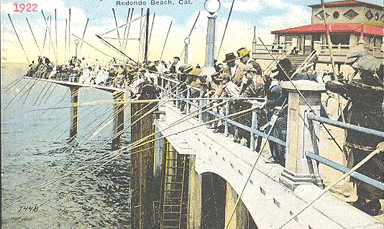
I recently took up fishing. This means that I have recently taken up drinking beer at the pier and on top of the cliffs overlooking the ocean. I sit and drink and watch the ocean alongside my voiceless companion, Fishing Pole. I enjoy Fishing Pole’s company, primarily because of his complete silence. He communicates only through infrequent gestures, and thus, does not disturb or cloud the comfortable ramble of my thoughts with unnecessary chatter. I also like Fishing Pole because, though he rarely communicates, when he does, it is profound. It’s an immediate and sharp bend towards the ocean and it means, “FISH!†And what greater joy exists than the fight of the catch and the satisfaction of receiving delectable sustenance from the environment that surrounds you?
***
Well, to be honest, I wouldn’t know. I think my fishing pole is mute, and the world is conspiring against me with my fishing endeavors. Despite research, advice from the bait shop and a slew of fishermen, not to mention many, many hours spent trying out everything I have heard, my fishing spoils equal zilch.
“Fishing†is an interesting verb; some like to joke that the reason they call the act of trying to catch fish, “fishing,†is because it is more accurate than the the verb, “catching.†True enough. Still, “fishing†seems misleading to those of us who are utterly bewildered with how to successfully participate in this sport. It didn’t occur to me to begin with the absolute basics of the sport until I had been proven so pathetically unsuccessful, for a significant duration, that I was forced to brainstorm how to overcome the myriad mistakes I was assuredly making.
First, I attacked the problem of not knowing what bait to use, what size hooks to tie on my line, and the effective technique for pier fishing. As I ventured into this unknown world I quickly came to realize that fishing is a uniquely individual sport. Not only in the sense in that it is often performed in solitude, but also that each fisherman has a specific set of guidelines that he believes incorporates the ingredients necessary for fishing fruition. And these guidelines are quite frequently in contradiction to the opinions of other fishermen, even at the same pier.
To set the scene, I’ll share with you some conversations. They went something like this:
Me: So what kind of bait should I use at the pier?
Fisher: I only use squid. Does the trick. Cut it up though. Whole squid is too big.
Me: OK, thanks. (Then I went and bought a bunch of squid and still have a ton of it in the freezer. No fish make residence in my freezer, however.)
Next conversation, after having no success:
Me: Hey, mind telling me what kind of bait you’re using?
Fisher: Yeah, you should get the sardines. Use a number 2 hook.
Me: Great. Thanks. (I caught nothing. I did however think that I hooked on a monstrous fish–which in reality was probably my hook caught in the rocks on the ocean floor–and struggled so hard against it that my line snapped and I lost my hooks and sinker…something that has occurred with unfortunate frequency since the first occasion.)
Next, again after having no success:
Me: You catch anything?
Fisher: Two so far. Sand perch.
Me: Nice, what kind of bait are you using?
Fisher: Shrimp. Nothing around here bites on anything else.
Me: Huh. Ok, thanks. What size hook?
Fisher: Number 4
This continued on in the same contradictory and confusing pattern. I can only conclude that perhaps this kind of advice should be taken as sort of a poll. The answer that comes up the most frequently is probably what you should go with. This requires a large pool of individuals, so ask everyone you see fishing, create a spreadsheet for the data, and base your actions on the numbers.
Other aspects of the sport that must be considered include the flow of the tide, the depth of the ocean, the type of fish you want to catch, how tight you want the drag, the type of bait, the time of year, the time of day, the daily migratory patterns of certain fish species, and about a million little pieces of gear that all apparently have a purpose and are a requirement in the fish-catching biz. But really, all of this is far too advanced for me (and likely many like me) at this stage. Oh, and did you realize that there are dozens of knots used in fishing?
Which brings me to the main purpose of this article: the basic knots even newbie fishermen like myself need to know.
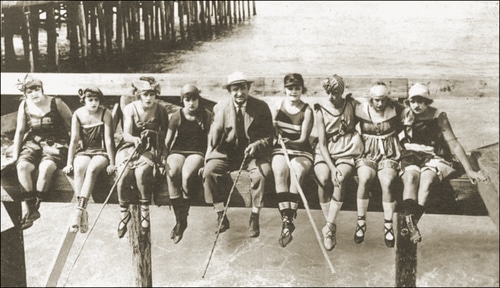
Pier Fishing: You may not catch any fish, but you’ll always reel in the ladies.
Image from Shutterstock
Knot Tying
You cannot go fishing if you cannot tie a knot. The first several times I took Fishing Pole out, I flustered and fought my hooks and sinkers onto the line with what I called the “mystery knot.†It is impossible to reproduce and generally doesn’t work in the way that it is intended. After a particularly frustrating evening of fishing and ending up with a “knot†that looked like a bird’s nest at the end of my line, I finally broke down and realized it was time to learn some fishing knots.
Different knots are used for different situations, and having a variety of them in your arsenal and knowing when to use them will help make you (and me) a successful angler. Though there are dozens of knots that can be used, there are three in particular that come up repeatedly as being the most important ones to know how to tie. They are the Palomar Knot, the Improved Clench Knot (also referred to as “the fisherman’s knotâ€), and the Blood Knot.
The Palomar: Popular among bass anglers and those who use braided lines, the Palomar Knot serves as the simple, “go-to†knot for many fisherman. While the knot works well with both monofilament and braided lines, it is particularly useful for braided, which can be difficult to make knots with.
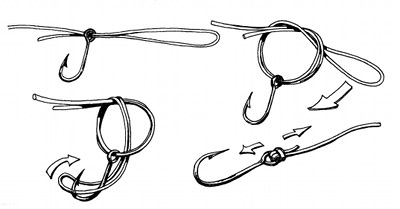
Step 1: Thread your line through the eye of the piece of tackle you are attaching. Thread it through the eye once again so that you end up with a four to six inch length of doubled line.
Step 2: Tie an overhand knot in the doubled line and let your hook hang loose. Don’t let the line twist and do not tighten it too much at this step.
Step 3: Pull the loop of line over your piece of tackle.
Step 4: Tighten the knot by pulling the tag end and holding the static line. To finish, clip the tag.
The Improved Clench Knot: An easy, common, and useful knot, the Improved Clench Knot serves as a versatile way of tying tackle to the end of your line. Trevor Kugler of JRWFishing.com suggests that you lubricate the line by putting the knot in your mouth before pulling it tight, which apparently makes it significantly stronger.
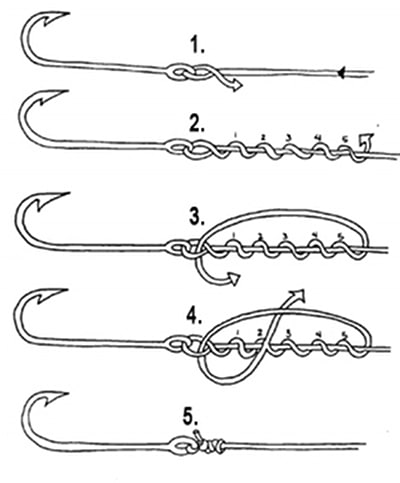
Step 1: Insert the end of your fishing line through the eye of the hook.
Step 2: Double back on the standing line and make five loops around it.
Step 3: After making your loops, bring the line back to the initial loop and thread the line through it from behind the eye of the hook.
Step 4: Thread the end of the line through the large loop, pull on the end of your line slightly so that the coils tighten, and pull on the standing line so that the coils draw tightly and neatly together.
Step 5: Cut the excess end line.
The Blood Knot: This is used for when you need to tie two pieces of fishing line together. Some make the mistake of using it for trying to tie a leader to a fly line, when a nail knot would actually serve the purpose better. That being said, the Blood Knot is the knot to use with lines of similar or exact diameter.
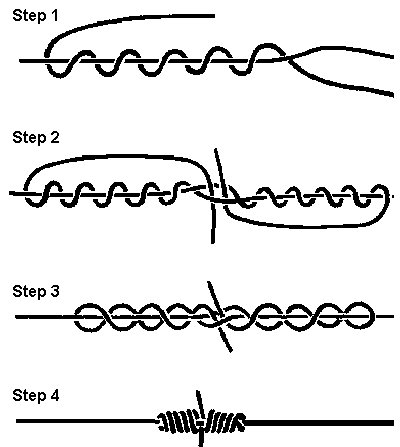
Step 1: Lay out your two lines facing in opposite directions of each other. Make sure they are of similar diameter, monofilament line. Pick one line and wrap it around the other three to four times.
Step 2: Thread the end of the line through the V that is formed by the two lines.
Step 3: Repeat steps one and two. When you thread the second end through the “V,” make sure it points in the opposite direction of the first line.
Step 4: Gently pull on the standing lines until the knot comes together. Before tightening it completely, place it in your mouth to lubricate it, thus making the knot stronger.
Step 5: Cut the tag ends.
Now that I’ve got some knots down, I’m heading back to the pier with at least a little more confidence. I’ll buy some shrimp, because that’s what most people were using who had actually caught some fish, and I’ll try my luck again! Hopefully I’ll be back with a proper “fish story.”
References and Resources:
Haig-Brown, Roderick. Fisherman’s Summer. William Morrow & Co. NY, 1959
Dahlem, Ted. How to Book of Knots, Nets and Smoked Fish. Great Outdoors Association. St. Petersberg, FL. 1968
What seems like an excellent source on Pier Fishing in California: www.pierfishing.com. Not that it will help those of you residing in other states/countries, but perhaps some of the information can translate to a variety of areas.
Tags: Knots

